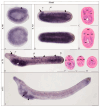The Expression of Shmt Genes in Amphioxus Suggests a Role in Tissue Proliferation Rather than in Neurotransmission
- PMID: 40710324
- PMCID: PMC12293503
- DOI: 10.3390/cells14141071
The Expression of Shmt Genes in Amphioxus Suggests a Role in Tissue Proliferation Rather than in Neurotransmission
Abstract
Serine hydroxymethyltransferases (SHMTs) are key enzymes in one-carbon metabolism, with vertebrates possessing two paralogs, cytosolic SHMT1 and mitochondrial SHMT2, implicated in nucleotide biosynthesis and glycine metabolism. In this study, we investigate the evolutionary history of animal Shmt genes and analyze the expression patterns of Shmt genes in developing amphioxus (Branchiostoma lanceolatum). Phylogenetic analyses indicate the presence of Shmt1 and Shmt2 orthologs in deuterostomes, spiralians and placozoans, which is consistent with an ancient Shmt gene duplication event predating bilaterian diversification. Gene expression analyses in developing amphioxus show that Shmt2 expression is confined to the somites and absent from neural tissues. In contrast, Shmt1 is broadly expressed across germ layers, but its transcription is restricted to tissues characterized by strong cell proliferation. Notably, Shmt1 expression in the nervous system does not match the distribution of glycinergic neuron populations, implying a negligible role in glycine neurotransmitter synthesis. Instead, the spatial correlation of Shmt1 expression with mitotically active domains suggests a primary function in nucleotide biosynthesis via one-carbon metabolism. These findings indicate that SHMTs predominantly support cell proliferation rather than neurotransmission in amphioxus.
Keywords: development; evolution; glycine biosynthesis; glycinergic neurons; one-carbon metabolism; serine hydroxymethyltransferase.
Conflict of interest statement
The authors declare no conflicts of interest.
Figures



Similar articles
-
Role of Mitochondrial and Cytosolic Folylpolyglutamate Synthetase in One-Carbon Metabolism and Antitumor Efficacy of Mitochondrial-Targeted Antifolates.Mol Pharmacol. 2024 Sep 17;106(4):173-187. doi: 10.1124/molpharm.124.000912. Mol Pharmacol. 2024. PMID: 39048308
-
Pharmacodynamic determinants of mitochondrial one-carbon flux and serine hydroxymethyltransferase inhibition in human tumors.Drug Metab Dispos. 2025 Jul 17;53(8):100120. doi: 10.1016/j.dmd.2025.100120. Online ahead of print. Drug Metab Dispos. 2025. PMID: 40816224
-
Multifaceted role of serine hydroxymethyltransferase in health and disease.Mol Cells. 2025 Sep;48(9):100262. doi: 10.1016/j.mocell.2025.100262. Epub 2025 Jul 28. Mol Cells. 2025. PMID: 40738465 Review.
-
Short-Term Memory Impairment.2024 Jun 8. In: StatPearls [Internet]. Treasure Island (FL): StatPearls Publishing; 2025 Jan–. 2024 Jun 8. In: StatPearls [Internet]. Treasure Island (FL): StatPearls Publishing; 2025 Jan–. PMID: 31424720 Free Books & Documents.
-
Glycine as a conditionally essential amino acid and its relationship to l-serine.Metabolism. 2025 Sep;170:156330. doi: 10.1016/j.metabol.2025.156330. Epub 2025 Jun 15. Metabolism. 2025. PMID: 40527450 Review.
References
-
- Garrow T.A., Brenner A.A., Whitehead V.M., Chen X.N., Duncan R.G., Korenberg J.R., Shane B. Cloning of Human cDNAs Encoding Mitochondrial and Cytosolic Serine Hydroxymethyltransferases and Chromosomal Localization. J. Biol. Chem. 1993;268:11910–11916. doi: 10.1016/S0021-9258(19)50286-1. - DOI - PubMed
MeSH terms
Substances
Grants and funding
LinkOut - more resources
Full Text Sources

